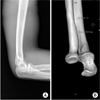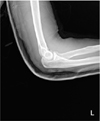Abstract
Most radial head fractures occur as the result of low-energy mechanisms, such as a trip or fall on the outstretched hand. These fractures typically occur when an axial load is applied to the forearm, causing the radial head to hit the capitellum of the humerus. Good results are shown with nonsurgical treatments for Mason type 2 fractures. However, if there is a limitation of elbow joint exercise or displacement of more than 2 mm, an operative treatment should be considered. We treated two patients with arthroscopic assisted bioabsorbable screw (K-MET™; U&I Corporation, Uijeongbu, Korea) fixation for radial head fractures to prevent complications of open reduction and minimize radiation exposure.
Figures and Tables
Fig. 1
A 30-year-old male with Mason type 2 radial head fracture. Anteroposterior radiograph (A) and saggital computed tomography (CT) (B), and a 3-dimensional CT (C).

Fig. 2
Right elbow arthroscopic photos. (A) Radial head fracture with articular step off. (B, C) The radial head was reduced with manipulation by the arthroscopic probe and micro curette.

References
1. Kang HJ, Moon ES, Park JO, Hahn SB, Yoon SP, Choi CH. Analysis of the factors influencing on the postoperative results of radial head fractures combined with elbow dislocation. J Korean Orthop Assoc. 2007; 42:599–607.

2. Mason ML. Some observations on fractures of the head of the radius with a review of one hundred cases. Br J Surg. 1954; 42:123–132.

3. Hotchkiss RN. Displaced fractures of the radial head: internal fixation or excision? J Am Acad Orthop Surg. 1997; 5:1–10.

4. Lee JG, Koh IH, Kim HS, Choi YR, Kim SJ, Kang HJ. Percutaneous mini-open reduction for Mason II or III radial head and neck fracture. Clin Should Elbow. 2010; 13:230–236.

5. Pappas N, Bernstein J. Fractures in brief: radial head fractures. Clin Orthop Relat Res. 2010; 468:914–916.

6. Fletcher C. Management of Mason II fractures of the radial head. EC Orthopaedics. 2016; 3:290–295.
7. Johnston GW. A follow-up of one hundred cases of fracture of the head of the radius with a review of the literature. Ulster Med J. 1962; 31:51–56.
8. Ring D, Quintero J, Jupiter JB. Open reduction and internal fixation of fractures of the radial head. J Bone Joint Surg Am. 2002; 84-A:1811–1815.





 PDF
PDF ePub
ePub Citation
Citation Print
Print






 XML Download
XML Download